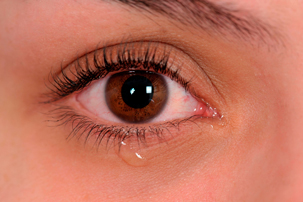
What is a tear film and why is it so important? |
| 12.05.2021 |
 It constantly covers the surface of the eye ball. Its most important role is to moisture and nourish the surface of the eye, which prevents corneal damage. It acts as a lubricant, facilitating free eyelid movements. Chemical substances contained in the tears (sodium chloride, albumins, lysozyme, globulin, ascorbic acid, sugar, urea and electrolytes), have antibacterial, antiviral and antifungal effects, consequently protecting the eyes from infections. It focuses the rays of light on the retina, which is why even minor disturbances in the continuity of the tear film affect visual acuity deterioration.
It constantly covers the surface of the eye ball. Its most important role is to moisture and nourish the surface of the eye, which prevents corneal damage. It acts as a lubricant, facilitating free eyelid movements. Chemical substances contained in the tears (sodium chloride, albumins, lysozyme, globulin, ascorbic acid, sugar, urea and electrolytes), have antibacterial, antiviral and antifungal effects, consequently protecting the eyes from infections. It focuses the rays of light on the retina, which is why even minor disturbances in the continuity of the tear film affect visual acuity deterioration.
 The tear film consists of three layers:
The tear film consists of three layers:The tear film must have an adequate composition and be produced in the right amount in order to be able to properly nourish and lubricate the eyes. Any abnormalities in one of the layers lead to a condition known as a dry eye syndrome. Most often, symptomatic treatment is used, but everything depends on which layer the disorder has occurred in.
Moreover, abnormalities in the action of the tear film can occur in the elderly due to age-related atrophy of the lacrimal glands, which in turn results in a decrease in the secretion of tears. This may also be caused by the use of certain medicines, including the ones used to treat hypertension, and arrhythmia, antihistamine ones or topical eye medications. Blinking enables an even tear distribution across the surface of the eyes. This is why too infrequent blinking, e.g. while looking at a computer screen, may also cause tear film impairment.
Tear film disorders may foreshadow a dry eye syndrome (DES). If you often experience dryness, burning, a sensation of a foreign body in the eye, or deterioration of visual acuity, you should contact an ophthalmologist and undergo a specialist examination to check whether you have the dry eye syndrome. Only a properly selected treatment, based on thorough examination, can bring satisfactory results.
In order to make an appointment for the examination call us, send us an email or fill in an online preliminary qualification form available on our website under the CONTACT tab.